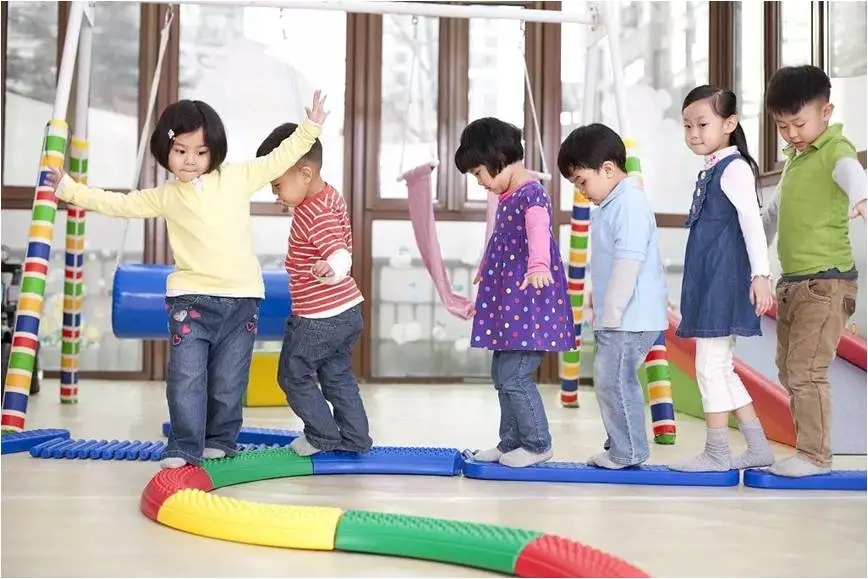这是 达医晓护 的第 3262 篇文章
上一篇我们介绍三到四岁孩子各阶段发育的科普。本次的主题是接着一起来看看学龄前儿童在四到五岁的正常发育轨迹,如何促进处于这个阶段的儿童发育,以及在什么情况下需要引起重视去看发育专科医生。
 情感和行为发展
情感和行为发展
在这个年龄,孩子们正在摸索学习如何表达情感。他们会尝试通过很多方式表达——例如,通过交谈、使用姿势或手势、发出噪音和在游戏中释放和表达情感。
这个阶段的学龄前儿童也喜欢和周围的人在一起。同时,想象中的朋友对他们来说也很重要。作为与他人相处的一部分,你可能会听到孩子和他人说对不起,认同游戏规则,当别人有好事情发生时会为之感到高兴。
在合作方面,你的孩子会比以前更乐于助人,虽然有时他们可能仍然要求很高。不过当孩子五岁的时候,他们可能会对自己的行为有更多的控制,发脾气也会减少。
孩子可能对将要开始去学校感到焦虑。爸爸妈妈们可以和你的孩子一起谈论这件事,甚至可以一起去学校,参观一下,都能帮助你减轻孩子的紧张或焦虑情绪。
从四到五岁开始,孩子有时可能会故意隐瞒事情的真相,甚至开始撒谎。例如,明明是做了,他们可能会说'我没有做'。这是学龄前儿童正常发育的一部分。
游戏和学习
玩游戏对孩子来说很重要,因为这是孩子学习和探索情感的方式。孩子会喜欢唱歌、跳舞和表演,同时,也喜欢过家家之类的装扮游戏,并且开始知道幻想和现实之间的区别。比起小时候,这个阶段的学龄前儿童会更有性别意识,并会开始玩基于性别的游戏——例如,女孩可能想在游戏里做“妈妈”。另外,孩子也可能会尝试不同的角色和行为,比如做医生或是结婚。
学龄前儿童可能对他们自己的和他人的身体非常好奇。例如,家长可能会发现孩子在看自己或其他孩子的生殖器。与生俱来的好奇心加上角色扮演的游戏通常是儿童性行为的一个典型部分。但如果你担心孩子的这些行为有异常,最好和儿科医生或儿童心理咨询专业人员谈谈。
思维
四到五岁的学龄前儿童更理解相反的词汇概念,例如,高/低。他们知道字母和数字的名字和顺序,并可以数到10。孩子能记住他们自己的地址,知道区分左和右。
语言
在四到五岁这个学前时期语言会有很大的发展。你可能会注意到孩子喜欢讲故事和交谈。同时孩子也可能会告诉你他们的感受,谈论他们的想法,问你很多问题,会说押韵的单词等。
四岁时,学龄前儿童知道数百个单词,能用5-6个或更多的单词造句。孩子说的话都能够被听懂。到了五岁,学龄前儿童可以说得更清楚,会知道、理解以及使用更多的单词构句,会达到一个句子有9个单词,并且通常会用更复杂的句型。
日常生活技能
自己穿脱衣服对于这个年龄的孩子来说已经很简单了。孩子可能会用筷子,叉子和勺子,不过仍然需要爸爸妈妈的监督和帮助。另外,孩子可以自己独立刷牙和去厕所。
运动技能
这个阶段的学龄前儿童喜欢运动和各种活动。双脚交替下楼梯,投球,接球和踢球,跑步,攀爬,双脚跳跃,单脚跳跃和平衡这些技能比以前越来越好。另外,孩子也在发展一些新的粗大运动技能-例如,跳绳,向后跳或边跑边跳。
同时,学龄前儿童的精细运动技能也在提高。孩子可以用儿童安全剪刀剪东西,写他们的名字和一些字母,会画圆圈,画出有身体部位和衣服的人的图画。
 如何促进4岁到5岁儿童发育?
如何促进4岁到5岁儿童发育?
1. 给孩子充足的玩耍时间
玩有助于学龄前儿童表达喜悦、兴奋、愤怒或恐惧等情绪。学龄前儿童喜欢玩沙子或泥巴里,玩布偶戏,或者在户外奔跑、翻跟斗、翻滚。
2. 找时间进行创造性和艺术性的游戏
可以是绘画、绘画或装扮换装游戏。做音乐游戏也是好方法-孩子可能会喜欢跳舞或用简单的乐器来做音乐。
3. 陪宝宝一起阅读
和孩子一起阅读、讲故事、唱歌和背诵童谣,可以鼓励孩子说话和培养他的想象力。
4. 和孩子一起做饭
这有助于你的孩子对健康食物感兴趣,学习一些新单词,并开始熟悉数学概念,如“一半”、“一茶匙”或“30分钟”。你可以让孩子做一些简单的烹饪活动,比如拌个沙拉或者做个三明治。
5. 与孩子一起玩游戏中要引导孩子学会分享和轮流交换
玩的时候,可以这样说:“现在轮到我搭积木塔了,然后挨到你玩”,或者“你给我一起玩红积木,我就把绿积木给你一起玩”。对于这个年龄段的孩子来说,学会分享还是有点难,所以当你的孩子有分享行为的时候,一定要给他很多表扬和鼓励。
6. 可以把孩子送到幼儿园
在幼儿园,孩子可以通过玩游戏来学习,交朋友,培养责任感、独立性和自信心。幼儿园可以帮助和鼓励你的孩子获得很大的进步,而且孩子会玩的很开心。
 在什么情况下需要引起重视去看医生
在什么情况下需要引起重视去看医生
如果观察到4岁的孩子有任何一项下述情况的,需要带孩子去就医进一步评估。
看东西或听东西有困难
不会说3个单词的短句
不懂简单的两步的指令--例如,“把娃娃放下来,把球捡起来”
不会玩角色扮演的过家家游戏—例如,不会玩假装做妈妈或爸爸
有行为问题--例如,因为很小的事情大发脾气,或者在你离开时还是很粘或者大哭大闹
在很多时候看上去很害怕,不高兴或是伤心难过
看上去很笨拙 --例如,走路或奔跑时容易绊倒
握拿小的东西有困难,比如铅笔,蜡笔
画简单的图形有困难,比如圆形或方形
自己吃东西,穿衣服或上厕所有困难
如果观察到5岁的孩子有任何一项下述情况的,需要带孩子去就医进一步评估。
看东西或听东西有困难
没有会话的技能—例如,不知道如何对话,倾听和回应。
不懂得三步骤的指令--例如,“把娃娃放下来,把球从椅子地下捡起来,放进盒子里”
不跟其他孩子玩,或行为好斗富有攻击性
在很多时候看上去很害怕,不高兴或是伤心难过
很容易分心,不能专心投入任何一项活动超过数分钟
不会玩角色扮演的过家家游戏—例如,不会玩假装做医生或护士,玩沙坑里施工,或做饭之类的游戏
看上去很笨拙 --例如,走路或奔跑时容易绊倒
使用小的物体有困难,比如铅笔或蜡笔
画简单的图形有困难,比如圆形或方形
自己吃东西,穿衣服或上厕所有困难
Preschooler development at 4-5 years: what’s happening
Feelings and behaviour
At this age, children are exploring and learning to express emotions. They do this in many ways – for example, by talking, using gestures, noises and in play.
Preschoolers also like to be around people. Imaginary friends could be important to your child too. As part of getting along with others, you might hear your child saying sorry, agreeing to rules and being pleased when good things happen to other people.
When it comes to cooperating, your child is likely to be more helpful, but sometimes they might still be demanding. By the time your child is five years old, they’ll probably have more control over their behaviour and fewer temper tantrums.
Your child might feel anxious about starting school. Talking to your child about this and even visiting the school together can help to ease any worries.
In this year, your child might hide the truth about things sometimes, or even start telling lies. For example, they might say ‘I didn’t do it’ even when they did. This is a normal part of preschooler development.
Playing and learning
Play is important because it’s still how children learn and explore feelings. When it comes to play, your child likes to sing, dance and act. Your child also loves make-believe play and is learning the difference between fantasy and reality. Your child is more aware of their gender and might want to play gender-based games – for example, girls might want to play at being ‘Mum’. Your child might also try different roles and behaviour, like being a doctor or getting married.
Your preschooler might be very curious about bodies – their own and other people’s. For example, you might find your child looking at their own and other children’s genitals. A combination of natural curiosity and role-playing is usually a normal part of childhood sexual behaviour. But if you’re concerned about a child’s sexual behaviour, it’s a good idea to talk with a GP, a paediatrician or another qualified health professional.
Thinking
Preschoolers understand more about opposites – for example, high/low. They know the names of letters and numbers out of order, and can count to 10. Your child might remember their own address and know the difference between left and right.
Talking
Children’s language develops a lot at 4-5 years. You might notice that your child loves telling stories and having conversations. Your child might also tell you how they feel, talk about their ideas, ask lots of questions and say words that rhyme.
At four years, preschoolers know hundreds of words and can use 5-6 words or more in sentences. You’ll be able to understand what your child is saying all the time. By five years, preschoolers can speak more clearly and will know, understand and use even more words, often in more complex sentences of up to nine words.
Daily life
Dressing themselves is pretty easy for children at this age. Also, your child can probably use a fork, spoon and sometimes a knife – for example, to spread butter on bread. You still need to supervise and help your child sometimes, but your child can go to the toilet and brush their teeth independently.
Moving
Preschoolers love moving and being active. Your child is getting better at walking down steps with alternating feet, throwing, catching and kicking a ball, running, climbing, jumping, hopping and balancing on one foot. Your child might also develop some new gross motor skills – for example, skipping, jumping backwards or jumping while running.
Your preschooler’s fine motor skills are improving too. Your child can cut with child-safe scissors and write their first name and some letters. Your child might also be able to draw a circle and make detailed drawings of people with body parts and clothes.
How to help preschooler development at 4-5 years
Give your child lots of playtime: play helps preschoolers express feelings like joy, excitement, anger or fear. Your child might like messy play in sand or mud, pretend play with puppets, and outdoor play with plenty of running, tumbling and rolling.
Make time for imaginative and creative play: this might be painting, drawing or dress-up games. Musical play is another idea – your child might like to dance, jump around or make music with simple instruments.
Read with your preschooler: reading together, telling stories, singing songs and reciting nursery rhymes all encourage your child’s talking, thinking and imagination.
Do some cooking with your child: this helps your preschooler to get interested in healthy food, learn new words and understand maths concepts like ‘half’, ‘1 teaspoon’ or ‘30 minutes’. You can give your child simple cooking activities, like tossing a salad or putting together sandwiches.
Play games with your child that involve learning to share and taking turns. When you play, say things like, ‘Now it’s my turn to build the tower, then it’s your turn’, or ‘You share the red blocks with me, and I’ll share the green blocks with you’. Sharing is still hard for children at this age, so give your child lots of praise when they share.
You might want to think about sending your child to preschool. At preschool your child can learn through play, make friends, and develop responsibility, independence and confidence. Preschool can support and encourage your child’s amazing development – and it can be a lot of fun too.
When to be concerned about child development at 4 years
has trouble seeing or hearing things
doesn’t use sentences of more than three words.
can’t understand two-part commands like ‘Put the doll down, and pick up the ball’
doesn’t pretend during play – for example, doesn’t pretend to be mum or dad
has very challenging behaviour – for example, has big tantrums over very small things or still clings or cries when you leave
seems very afraid, unhappy or sad a lot of the time.
is clumsy – for example, trips over a lot when walking or running
finds it hard to handle small objects – for example, a pencil or crayon
has trouble drawing shapes – for example, a circle or cross
has difficulty eating, dressing or using the toilet.
When to be concerned about child development at 5 years
has trouble seeing or hearing things
isn’t developing conversational skills – for example, doesn’t understand how to talk, listen and respond.
can’t understand three-part commands like ‘Put the doll down, get the ball from under the chair and put it in the box’
doesn’t play with other children or acts in a very aggressive way
seems very afraid, unhappy or sad a lot of the time
is easily distracted and can’t concentrate on any single activity for more than a few minutes
doesn’t pretend during play – for example, doesn’t play doctors and nurses, construction in the sandpit or cooking.
is clumsy – for example, trips over a lot when walking or running
finds it hard to use small objects – for example, a pencil or crayon
has trouble drawing shapes – for example, a circle or square
has difficulty eating, dressing or using the toilet.
作者:澳大利亚墨尔本大学医学院儿科博士
百汇医疗(中国)儿科医师
蒋本然




 扫码下载APP
扫码下载APP

 科普中国APP
科普中国APP
 科普中国
科普中国
 科普中国
科普中国